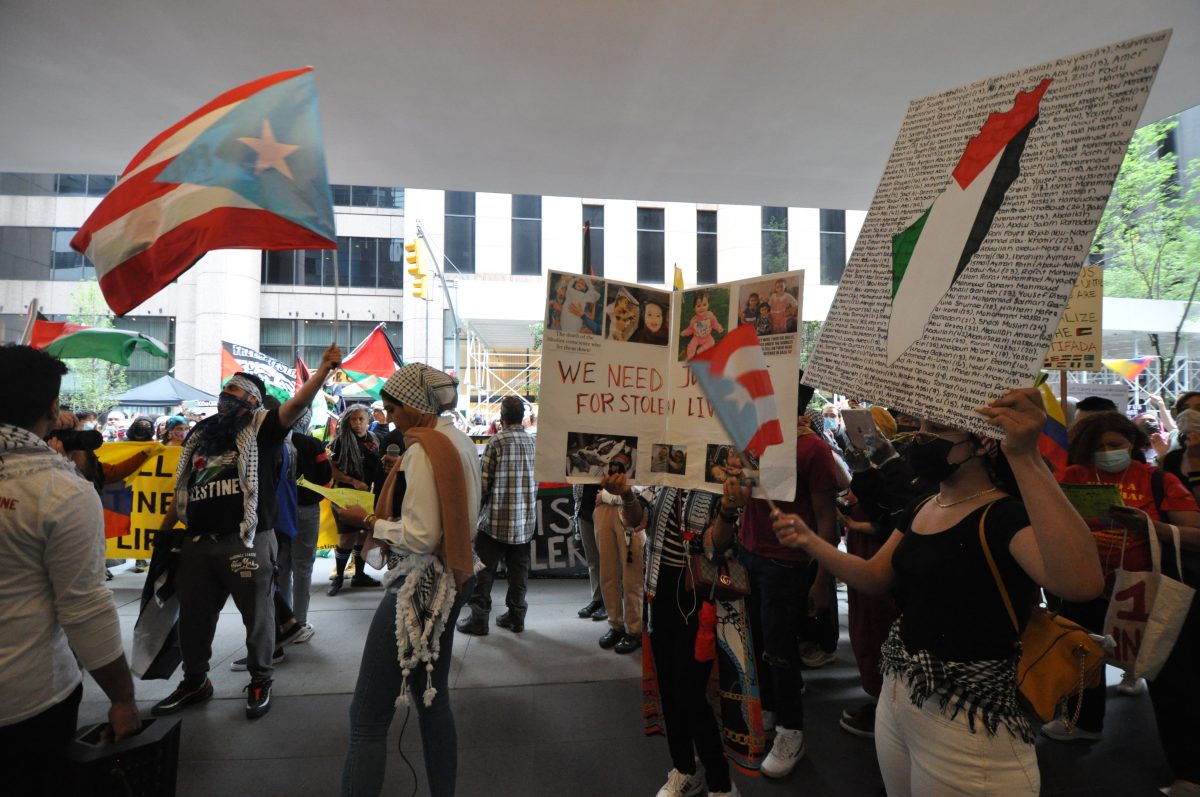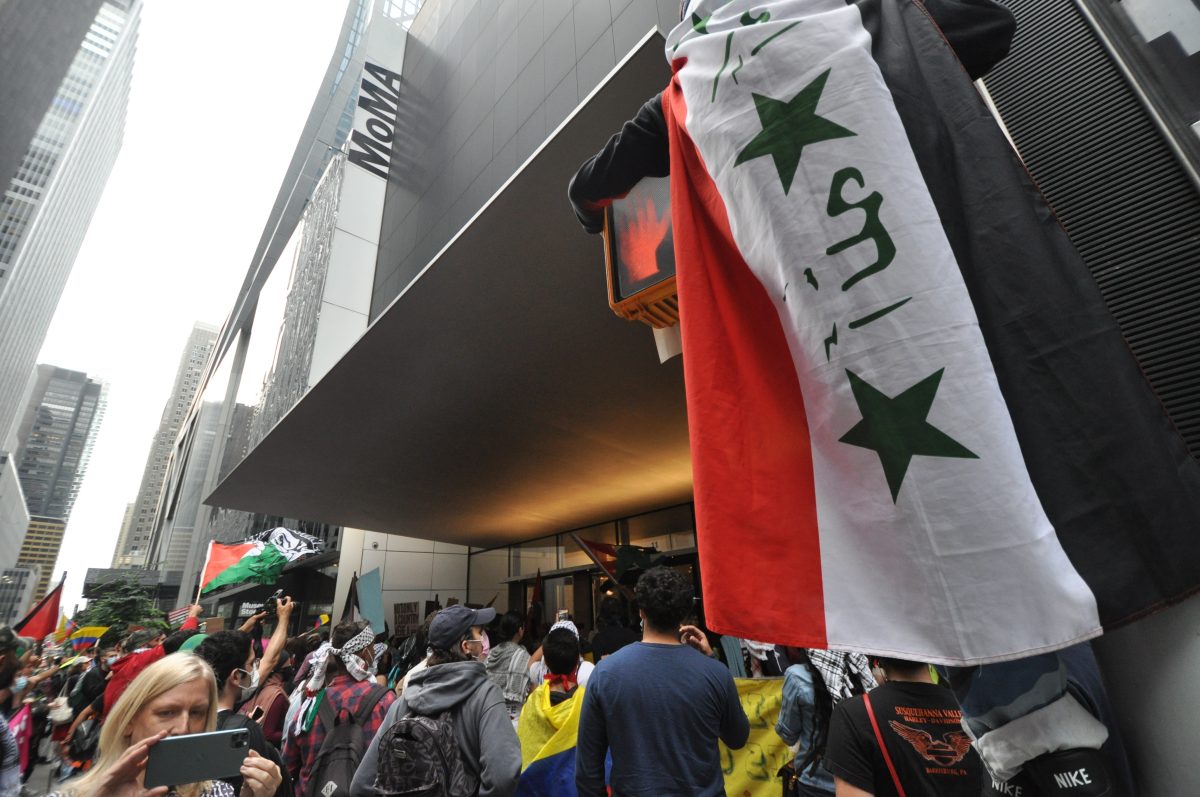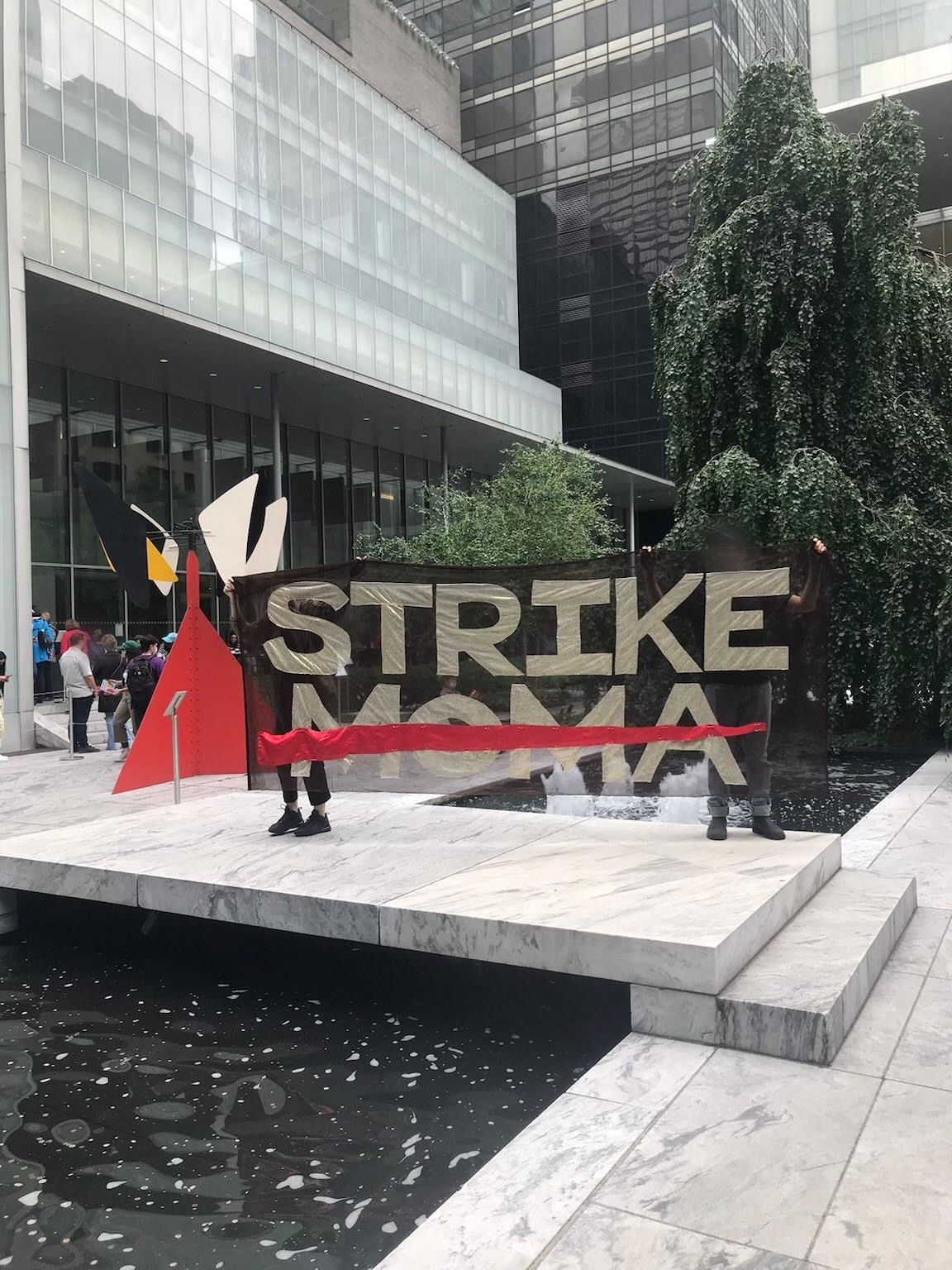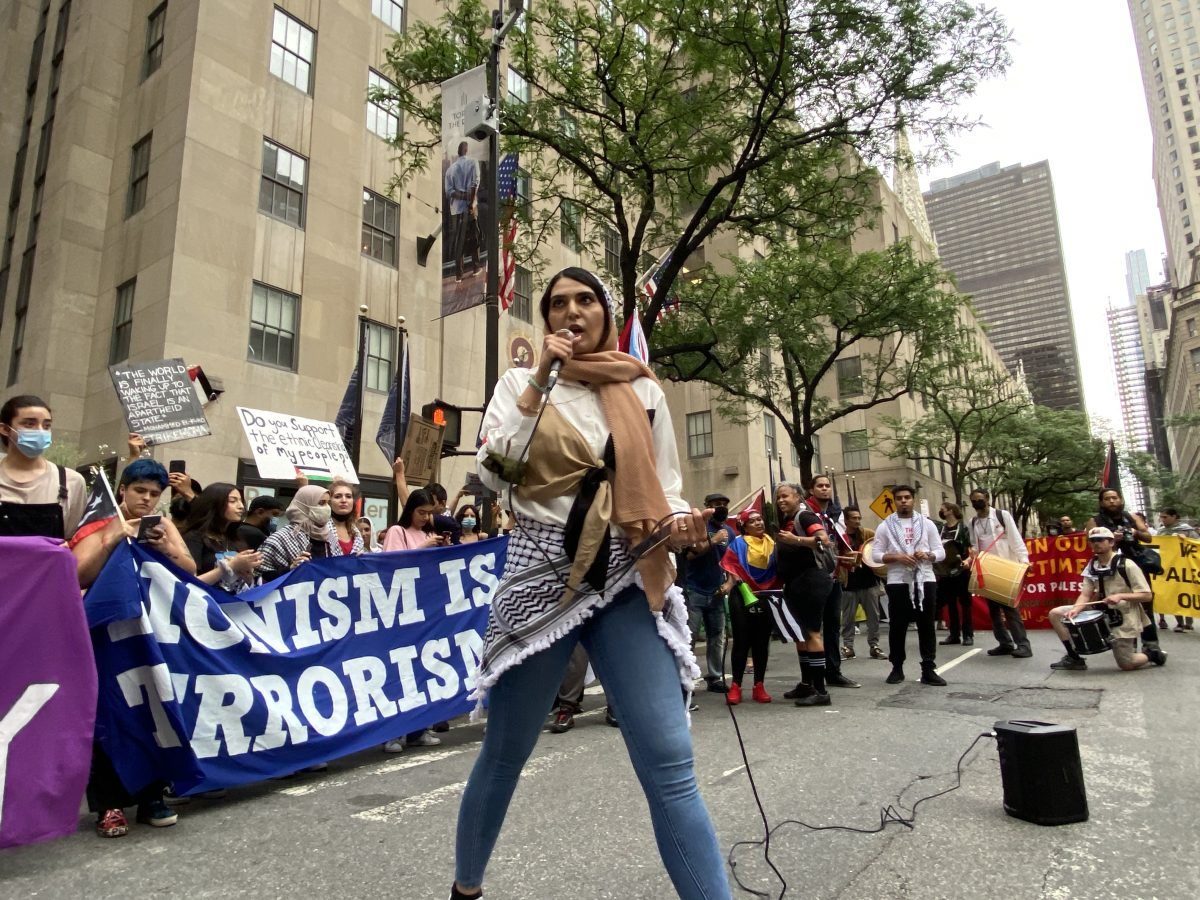

When Strike MoMA activists arrived at Manhattan’s Urban Plaza on the afternoon of Friday, June 11, their usual gathering spot in front of the Museum of Modern Art had been fenced off on both sides. Undeterred by the unexpected barricade, more than 200 demonstrators marched toward MoMA’s entrance. (A lobby attendant at the building adjacent to the plaza, owned by Paramount Group, told Hyperallergic that the fencing was erected due to construction work and was unrelated to the planned protest.) At the museum’s doors, they began their final action in a 10-week series of efforts to expose toxic philanthropy and advocate for institutional reform.
The months-long Strike MoMA campaign has been led by the International Imagination of Anti-National Anti-Imperialist Feelings (IIAAF), a coalition of diverse activist and artist groups. By exposing the unscrupulous sources of wealth of several MoMA trustees, the strikers have shed light on human rights violations and environmental crises around the world, from toxic mining in Latin America to lethal Israeli strikes on Gaza.

At the core of the new movement is the concept of “interconnected struggles”: oppressed peoples’ shared experiences of apartheid, settler violence, environmental degradation, and imperialist intervention. In recent actions, the group has focused on the intertwined plights of Colombia and Palestine, nations under siege by militaries heavily funded by Western powers. Through writings, research, and online discussions, the activists also sought to change the conversation around museum funding and imagine a future wherein institutions like MoMA are not beholden to billionaire donors.
Alongside the weekly protests and teach-ins, the group Artists For a Post-MoMA future has carried out several online interventions, including a mock MoMA website satirizing its board members and announcing fictional exhibitions such as Modern Masters: Prison Slavery, Policing and Border Detention. Earlier this week, the group nominated MoMA as an “at-risk cultural heritage site” to the World Monuments Fund, arguing that “the well-being of the artworks inside the building is made possible by the discomfort and death of others we do not see.” Artist Michael Rakowitz, who is active in the group, has posted a series of satirical videos in the character of Edvard Munch’s “The Scream,” a painting in the collection of MoMA trustee Leon Black. The financier recently stepped down from his role as chairman of the board in the wake of several scandals, including his financial ties to convicted sex offender Jeffrey Epstein and connections to Constellis, a private security firm tied to the killings of Iraqi civilians.

Around 4pm, a swarm of activists huddled in front of the glass doors of the museum, where speakers kicked off the action with speeches about conflicts in Colombia and the Dominican Republic. They chanted “Out, Barrick Gold” — referring to the multinational mining company where Gustavo Cisneros, husband of MoMA trustee Patricia Phelps de Cisneros, sits on the board of directors. The couple may be best known for their patronage of Latin American artists, but Bronx activists Sandy Placido and Manny Roa amplified the Cisneros’s ties to the Pueblo Viejo mine in the Dominican Republic, one of the largest gold mines in the world, which locals say has contaminated groundwater, air, and soil. (Barrick Gold has not responded to Hyperallergic’s repeated requests for comment.)
“El agua es un tesoro, que vale más que el oro,” chanted the group — “Water is a treasure worth more than gold.”


Inside the museum, the atmosphere was tense as the protesters blocked the entrance outside. MoMA staffers were on high alert, but a group of five activists managed to sneak in a large Strike MoMA banner and unfurl it at the museum’s Abby Aldrich Rockefeller Sculpture Garden. The protesters later told Hyperallergic that they were escorted out of the museum when they tried to unfold the banner inside the galleries. (MoMA has not responded to Hyperallergic’s repeated requests for comment.)
Visitors mostly abandoned the art displays to record the spectacle at the entrance with their phones. Hyperallergic spoke with several patrons who were split on their opinions about the protest.
“This gives me doses of anxiety,” said Angelis, a MoMA member from New Jersey. “They have no right to impinge on my moment.”
“If you nitpick on any organization, you’ll find these conflicts of interest but what does it have to do with me?” continued Angelis, a former journalist. “Am I going to stop coming to the museum because a board member is involved in something that these protesters think is unethical? I don’t even care about the board. I come for the art.”
Her husband, who asked to remain anonymous, had a different view. “Bad donors should be kicked out of the board,” he said.
-

Protesters unfurling a “Strike MoMA” banner at the museum’s sculpture garden (courtesy of Kevin Allin) -

Protesters say they were asked to leave the museum when they tried to unfold the banner inside the galleries.
Thomas Lozada, a Bangkok-based architect visiting the city, sympathized with the protesters but disagreed with their tactics. “The cause certainly holds merit but they shouldn’t be blocking people from entering the museum,” he said.
Roni and Malka, a couple from Israel who were visiting their daughter, a student in Boston, shared their feelings about the Palestinian flags that were being waved outside the museum.
“They have every right to be angry,” Malka said. “We’ve done some awful things to Palestinians.” Her husband opened up about his service in the Israeli army, saying: “I entered homes of old people in the West Bank, turned their beds and broke their walls. I did these things because I was scared for my life.”
The couple said that they believe in a two-state solution and denounced “extremism on both sides.”
“It’s not too late to talk to each other,” Roni said. “Both sides can still negotiate and reach a compromise.”



Led by a band of percussionists, the activists then marched energetically across Midtown Manhattan, stopping at key sites: the headquarters of BlackRock, a company owned by MoMA trustee Larry Fink that invests in private prisons; GoldenTree Asset Management, a hedge fund founded by trustee Steven Tananbaum accused of profiting from Puerto Rico’s debt crisis; and the New York City Police Foundation, among others. “This is class war,” they chanted at several stations. At BlackRock, they sprayed red paint across the building’s entrance.
This “zone of operations” was marked on a bright green map distributed to attendees. (When Hyperallergic reporter Hakim Bishara entered the museum during the protest, he was asked by MoMA security to discard the map before being allowed inside.)

Tensions at the museum have been high after clashes between protesters and museum staffers over the past few weeks. On April 30, MoMA security guards blocked protesters from entering the museum to lead a tour of the galleries. An activist and former MoMA educator said she was struck repeatedly by a guard, a claim corroborated to Hyperallergic by several witnesses. The museum alleged that two of its security officers were injured in standoffs with demonstrators, but has not provided evidence to Hyperallergic for these claims. Strike MoMA denied the allegations, condemning “MoMA leadership’s attempt to distort the nature of the confrontation at the museum” and calling Lowry a “gaslighter-in-chief.”
The following Friday, an action centered on the human rights of Palestinians culminated in the arrest of one protester, who was tackled by police. The museum has also permanently banned five activists who were involved in the April 30 incident from entering it grounds.
In a leaked all-staff email that was obtained by Hyperallergic, the museum’s director Glenn Lowry portrayed the protests as an attempt to “destroy MoMA.” But in its few public responses to the weekly actions, the museum has remained reticent, never addressing concerns about its trustees and rarely commenting on the demonstrations. The museum’s wall of silence has not prevented the movement from gaining steam, however, with the protests going from just a few dozen attendees to hundreds at their peak, and even drawing supporters from within the museum itself. Artist Gabrielle L’Hirondelle Hill, who currently has a solo exhibition at MoMA, withdrew her participation from two activities at the museum this week in solidarity.
“It does not feel right to participate in programming for families sponsored by an arms manufacturer profiting from the death of those children,” she wrote in a letter to MoMA’s leadership, referring to the weapons conglomerate General Dynamics, owned by James Crown, husband of museum trustee Paula Crown. (General Dynamics has not responded to Hyperallergic’s request for comment.)


The protesters concluded the last action with a peaceful march through the streets of Midtown Manhattan at the Rockefeller Center, where they gathered in a circle to hear final speeches. “The money from the Rockefellers created MoMA,” said one of the speakers. “It’s no surprise that they wash their blood money with art. We will go to where these people feel comfortable to profit from our peoples and we will fight for Colombia and the Dominican Republic like we fight for Palestine.”


The demonstrators then returned to MoMA for an “after-party” to celebrate the conclusion of 10 weeks of action. The New York Police Department (NYPD) blocked traffic on West 53rd street while several officers guarded the museum’s entrance. Around 9pm, Strike MoMA and the Illuminator collective held a guerrilla projection onto the museum’s facade. The protesters erupted in cheers as messages such as “Strike MoMA,” “Strike Modernity,” and “Free Palestine” illuminated the building. Other projected images showed members of MoMA’s board with texts describing the allegations against them.
With loudspeakers blasting tunes from Palestine, Colombia, Puerto Rico, and the Dominican Republic, the protesters danced and socialized in front of MoMA until 10:30pm.
Two MoMA workers present at the action, who spoke to Hyperallergic on condition of anonymity, were enthusiastic about Strike MoMA’s aims and planned on attending prospective actions. Hopeful for the future, they said: “These 10 weeks were just tilling the soil and planting the seeds.”







0 Commentaires